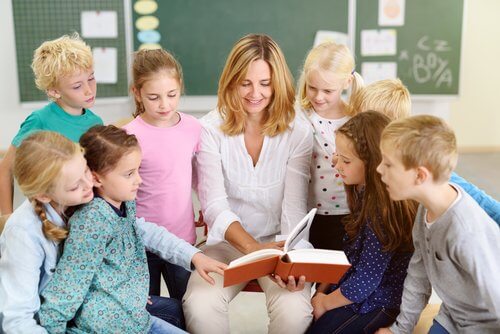How to Work with Children's Emotions Through Stories

Many everyday spaces are ideal for working with children’s emotions through stories. For example, parents can do this in their own homes, while teachers can use the classroom.
Education is more than just teaching children to read, write and count. Controlling emotions is also part of the teaching that little ones need to receive.
Anger, loneliness, insecurity, sadness, pride and jealousy are all examples of emotions that children can experience from an early age.
Generally, because they’re so young and our of lack of experience, children have a hard time identifying what they feel and why.
That’s why we want to highlight the benefits of working with children’s emotions through stories. Stories explain all sorts of emotions to children in a simple way that allows them to comprehend easily.
Working with children’s emotions through stories
Happy children usually enjoy good emotional health. Family is an essential part of that. At the same time, stories are a very effective tool in the process of emotional development.
Through refreshing and simple readings with a level of emotional consciousness, children can come to modify inappropriate behavior.
Children can do this on their own or with company, however they prefer. Once the reading is through, it’s good to discuss the content.
Emotions that reading can address
Through reading material that allows for reflection, children develop social abilities that are important for their future. Through reading, they come to identify emotions and also learn to respect and value those of others.
Stories are wonderful thanks to their content, messages, drawings and illustrations. Most importantly, they feed children’s imagination in an incomparable way.
They help children to reflect on, talk about and discuss anyone’s emotions. This makes conversation more comfortable and nourishing.
So then, it’s first a matter of identifying the emotions that children are having trouble handling. And then, offering an appropriate story to help them do so.
Fear
Fears are normal, evolutionary, and change as children grow up and mature. This emotion can manifest itself in several ways: Fear of growing up or being alone, fear of a specific object, fear of the dark, among others.
Readings about this feeling can help children overcome their fears in a proactive and educational way. You can look for short stories about protagonists that overcome obstacles or fun tales that talk about fear.

Fear manifests itself as insecurity, fear of making mistakes, and fear of disappointing others. It affects shy children especially. A story in which the main character has a healthy self-esteem is great for addressing this type of emotion.
Frustration
This is an emotion that often combines with deception, helplessness and sadness. Children experience frustration in the face of a challenge or task.
The best way to combat frustration is through tolerance. In other words, children learn to accept their limitations and focus on the goals they can achieve.
Stories that narrate sports competitions or the creation or construction of some object can help children to build up their confidence.
“Through refreshing and simple readings with a level of emotional consciousness, children can come to modify any inappropriate behavior”
Jealousy
Jealousy can develop when children feel sincere love for someone, but are reluctant to share that person with others. It generates many conflicts among friends and also produces a great deal of loneliness.
Stories that place emphasis on the value of friendship are best for helping children control their feelings of jealousy. The friendship featured in the story should be a harmonious one, and the story should show how another person can affect it.
Anger
It’s inevitable for human beings to feel anger at some point in their lives. However, we must all learn how to keep it from holding us prisoner when we face unpleasant circumstances.
Children tend to have a very hard time dealing with anger and are prone to reacting in an aggressive and offensive way. It’s good to offer them examples of how different characters control their anger in a healthier and more productive way.
We recommend looking for stories that express tolerance, respect for different opinions, forgiveness and patience. These are all ideal tools when it comes to helping children control their anger.

Gratitude
Gratitude is a positive emotion that focuses on the good things in life and being thankful for what we have. Stories that reflect accepting and valuing the things we possess – be it family, nature, etc. – are good for reinforcing feelings or gratitude.
So then, working with children’s emotions through stories is a fun and effective teaching method. Using children’s literature helps children explore many aspects of personal, educational and spiritual growth.
In conclusion, all of these activities help little ones develop their vision of things and value the lessons they glean from any situation. Lastly, it teaches them to be better people.
All cited sources were thoroughly reviewed by our team to ensure their quality, reliability, currency, and validity. The bibliography of this article was considered reliable and of academic or scientific accuracy.
- Bisquerra, R. (2011). Educación emocional. Propuestas para educadores y familias. Bilbao: Desclée de Brower. http://otrasvoceseneducacion.org/wp-content/uploads/2019/04/Educación-Emocional.-Propuestas-para-educadores-y-familias-Rafael-Bisquerra-Alzina-2.pdf
- Goleman, D. (2010). La práctica de la inteligencia emocional. Editorial Kairós.
- López, M. (2008). La integración de las habilidades sociales en la escuela como estrategia para la salud emocional. Psicología sin fronteras: revista electrónica de intervención psicosocial y psicología comunitaria, 3(1), 16-19.
- Shapiro, L. E. (2002). La salud emocional de los niños (Vol. 16). Edaf.
This text is provided for informational purposes only and does not replace consultation with a professional. If in doubt, consult your specialist.








